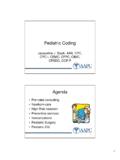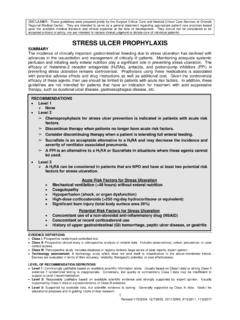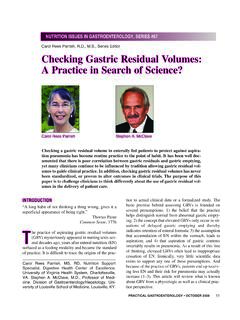Transcription of Nutrition Practice Care Guidelines for Preterm Infants in ...
1 Nutrition Practice care Guidelines for Preterm Infants in the Community Developed by: Oregon Pediatric Nutrition Practice Group Revised 2016. Members of the 2000-2001 Working Group: Jeanne Bacot, MPH, RD Lana Peth, RD. Mary Davis, RD Linda Phelan, RD, CSR. Janet Harris, RD Claudia Smith, RD, CDE. Vicki Look, RD Diane Smith, MA, RD. Joan Ottinger, MS, RD. Members on the Revision Workgroup for 2002 : Elizabeth Berol-Rinder, RD Linda Phelan, RD, CSR. Mary Davis, RD Sue Ring, RD. Susan Greathouse, MPH, RD Diane Smith, MA, RD. Members on the Revision Workgroup for 2006 : Andi Dietz, RD Linda Phelan, RD, CSR. Susan Greathouse, MPH, RD, IBCLC Sue Ring, RD. Melissa Nash, MPH, RD Melissa Stawarz, RD. Jennifer Niemeyer, RD. Members on the Revision Workgroup for 20 13: Cheryl Alto, MS, RD Linda Phelan, RD, CSR.
2 Andi Markell, RD Kirti Raol, MS, RD. April Mitsch, MS, RD Sue Ring, RD. Melissa Nash, MPH, RD Kim Rondeau, RD. Mia Neeb, RD Melissa Stawarz, RD. Jennifer Niemeyer, RD. Members on the Revision Workgroup for 20 16: Cheryl Alto, MS, RDN Melissa Nash, MPH, RD. Andi Markell, RD Jennifer Niemeyer, RD. April Mitch, MS, RD, IBCLC Melissa Stawarz, RD. For questions and/or comments on these Guidelines , please contact Melissa Nash at Formatted by: If you need this information in large print or an alternate format, please call (971) 673-0040. WIC is an equal opportunity program and employer Also available online: Nutrition Practice care Guidelines for Preterm Infants in the Community Goal These Guidelines have been designed to assist WIC and community-based health professionals in caring for the high-risk Preterm infant to ensure optimal post- discharge growth and development.
3 Nutrition screening and assessment should be performed routinely for any infant born premature and/or with a low birth weight. Statement of intent The Oregon Pediatric Nutrition Practice (OPNPG) workgroup has generated a set of guideline recommendations to provide guidance to health care providers on the clinical aspects of Nutrition management of the Preterm infant while at the same time recognizing the limited evidence that exists. These recommendations are based on evidence available at the time of revision and they also rely heavily on the clinical experiences of the workgroup members. Table of contents Definitions ..1. Chapter 1: Discharge of the Preterm infant into the community ..3. Transitioning home Infants at highest risk post-discharge Feeding concerns for high-risk newborns at discharge Table : Feeding concerns for high risk Preterm Infants Referral criteria for further assessment and follow-up Anthropometric red flags.
4 Clinical red flags . Feeding red flags . Selection of feeding at discharge Chapter 2: Growth assessment ..14. Growth charts commonly used to monitor Preterm Infants Table : Growth charts commonly used to monitor Preterm Infants Developmental origins of health and disease Estimating catch-up growth Table : RDAs for energy and protein Age correction for Preterm Infants Growth velocity Table : Growth parameters for Preterm Infants Chapter 3: Energy, nutrient & biochemical recommendations ..23. Nutrient recommendations for the Preterm and term Infants Table : Nutrient & energy recommendations for Preterm and term Infants Table : Estimated Energy Requirement equations (EER). Vitamin and mineral supplementation Table : Vitamin and mineral supplementation for Preterm Infants Important biochemical parameters for post-discharge Preterm Infants Table : Reference table for biochemical parameters Case Studies: Use of Tribasic for the breastfed Preterm infant Fluid requirements Table : Daily maintenance fluid requirements based on weight Table : Dietary reference intake (DRI) for fluid Chapter 4: Breastfeeding considerations.
5 35. Fortification of human milk Table : Breastfeeding progression for the Preterm infant Storage Guidelines for pumped breastmilk Table : Breastmilk storage Guidelines (without fortification added). Table : Fortified breastmilk storage Guidelines Pumping and maintaining milk supply for the Preterm infant Table : Types of Breastpumps Banked human milk Chapter 5: Breastmilk, formula and fortification ..51. Human milk and formula descriptions Table : Human milk and formulas Developing a formula recipe Formula preparation and storage Guidelines Table : Storage instructions for fortified breastmilk and prepared formula Chapter 6: Nutritional interventions for Preterm Infants Feeding progression for the Preterm infant Table : Feeding your Preterm infant step-by-step Constipation in the Preterm infant Probiotic use in Preterm Infants Table : Probiotics and prebiotics use in Preterm Infants Chapter 7: Special considerations for late Preterm Infants .
6 72. Medical risks for the late Preterm Infants Feeding the late Preterm infant Definitions Preterm infant defined by Weight ( Classification): Low Birth Weight (LBW): Birth weight < 2500 grams (5 lbs). Very Low Birth Weight (VLBW): Birth weight < 1500 grams (31/3 lbs). Extremely Low Birth Weight (ELBW): Birth weight < 1000 grams (2 lbs). Preterm infant defined by Age (WHO Classifcation): Moderate to Late Preterm : 32 to <37 weeks Very Preterm : 28 to 32 weeks Extremely Preterm : <28 weeks Late Preterm : Infants born between 34-37 weeks gestational age. Appropriate for Gestational Age (AGA): Usually defined as Infants born with growth parameters plotting between the 10th and 90th percentile. Large for Gestational Age (LGA): Infants born with growth parameters greater than two SD. from the mean, usually defined as above the 90th percentile.
7 Small for Gestational Age (SGA): Infants born with growth parameters less than two SD from the mean, usually defined as below the 10th percentile. Intrauterine Growth Restriction (IUGR): Failure to sustain intrauterine growth at expected rates; can be caused by placental insufficiency, infection, malnutrition, etc. May or may not be born prematurely. Asymmetric SGA: Infants who have reduced body weight, but growth for head and length have been spared; often indicates short-term intrauterine growth restriction. Symmetric SGA: Infants born with small body (weight and length) and head growth; often indicates that the intrauterine growth restriction was prolonged. NICU: Neonatal intensive care Unit Occipital frontal circumference (OFC): Head circumference EMM: Expressed Mother's Milk 1. Age terminology and definitions during the perinatal period: Committee on Fetus and Newborn et al.
8 Pediatrics 2004;114:1362-1364. Gestational Age: Indicates time elapsed between first day of the last menstrual period and the day of delivery in weeks and days. Chronological age (CH) or actual age : Indicates the time elapsed from the actual day of birth in days, weeks, months, and years. Also known as postnatal' age. Corrected Age (CA): Chronological age minus the number of weeks born before 40 weeks in weeks, and months. Also known as adjusted age and is the more appropriate term used post discharge to describe children up to 3 years of age who are born Preterm . Postmenstrual Age (PMA): Indicates the time elapsed between the first day of the last menstrual period and birth (gestational age) plus the time elapsed after birth (chronological age). in weeks and days. This is the preferred term used to describe the age of the Preterm infant during the perinatal period neonatal hospital stay.
9 After the perinatal period, corrected age is the preferred term. 2. CHAPTER 1. Discharge of the Preterm infant into the community Improvements in medical and nutritional care have resulted in an increase in survival rates for Infants born less than 36 weeks gestation. As these smaller Infants survive, the morbidity rates for very low birthweight (<1500 g) Infants have increased. Infants are being discharged into the community earlier for many reasons. Earlier discharges decrease the length of time the infant is separated from his or her parents, improves bonding and reduces the potential negative effects on parenting. Fewer days in the NICU reduces the risk of the infant contracting infections while hospitalized, which would significantly increase the number of days in the hospital. Another major reason that a premature infant may be discharged earlier is to keep medical costs reduced allowing the NICU to target their resources toward the higher risk Infants requiring more intensive care .
10 However, some of these Infants discharged early are re-admitted due to failure to thrive and feeding problems. This is often due in part to a lack of, or gaps in, coordinated care and follow-up in the community. Transitioning home Infants at highest risk post discharge: VLBW and ELBW. Small for gestational age (SGA) and Intrauterine Growth Restriction (IUGR). Primarily breastfeeding with no fortification, depending on gestational age and birth weight Infants on special formulas Infants who require tube feedings at home Infants on total parenteral Nutrition (TPN) > 4 weeks during hospitalization or on parenteral Nutrition after hospital discharge Infants with gastrostomies or tracheotomies Infants with slow weight gain prior to hospital discharge (gaining < 20 g/d). Infants with any of the following complications of prematurity: o Chronic lung disease/Bronchopulmonary dysplasia o Chronic renal insufficiency o Congenital alimentary track anomalies o Short bowel syndrome o Cyanotic congenital heart disease o Osteopenia of prematurity o Anemia of prematurity o Severe neurological impairments o Drug and/or alcohol exposure in utero o Poverty or low socioeconomic status 3.
















